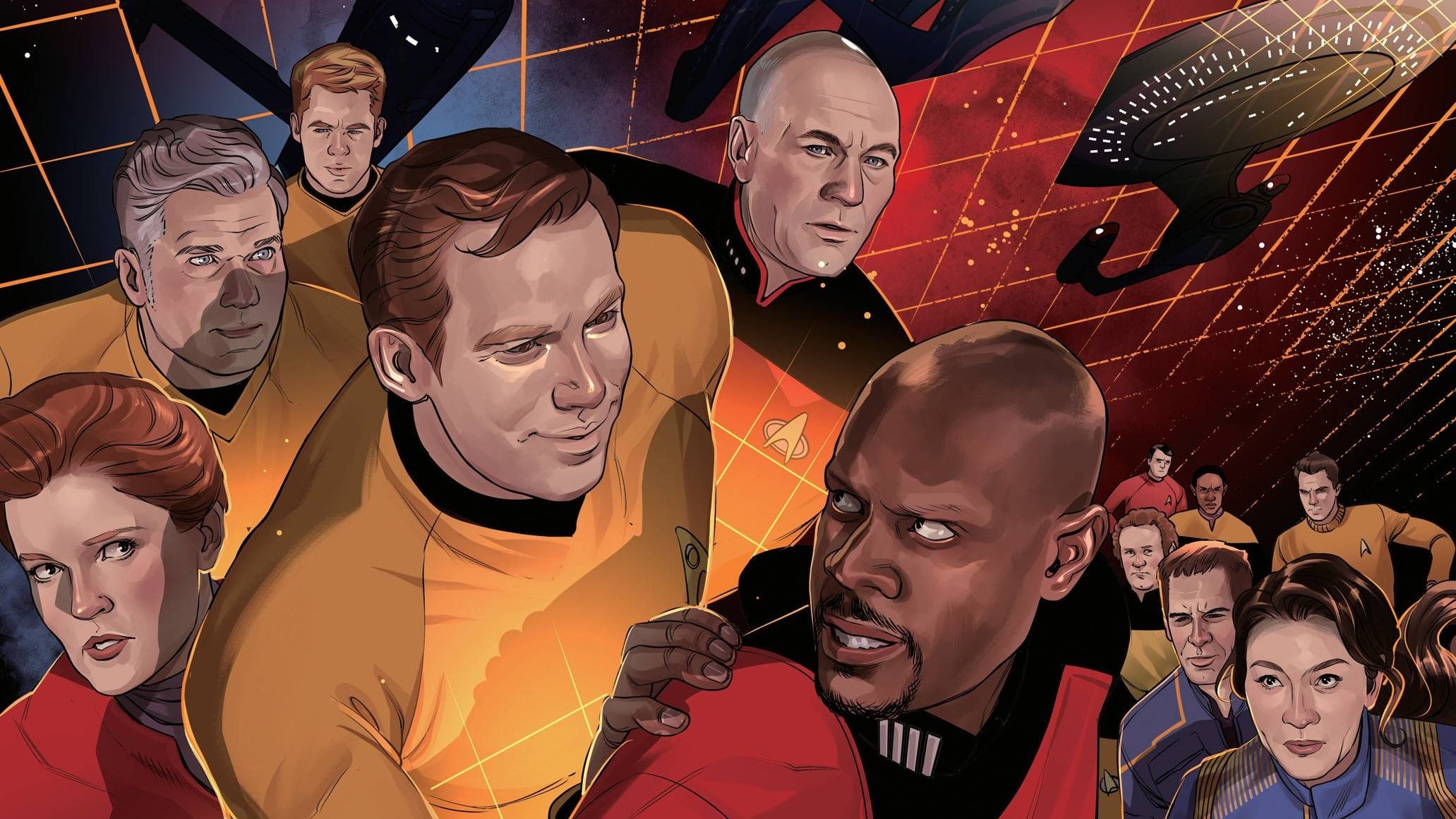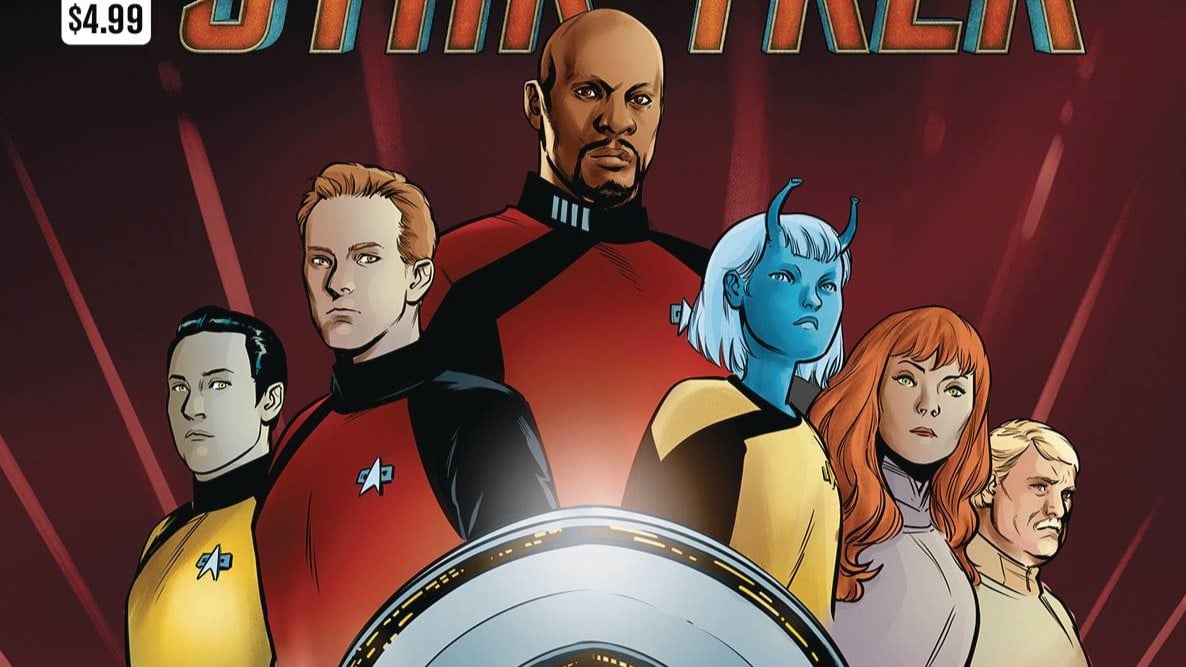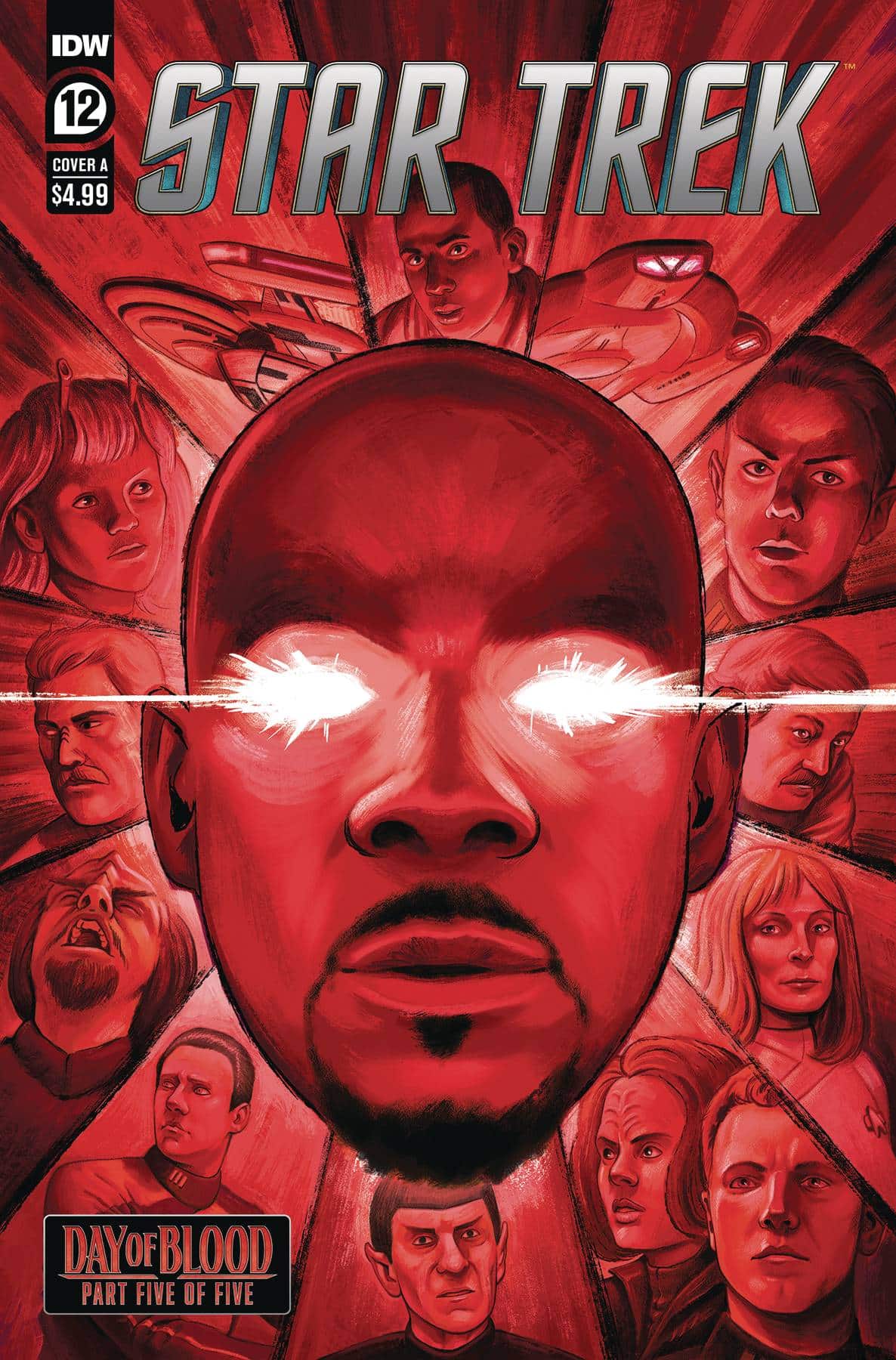Worf is angry with Spock, Spock is distrustful of Lore, Ro and Torres can’t get along, and the new Orion pirate crewmember is a great big wildcard. What could go wrong for the Defiant? Meanwhile, Data runs a game of Dungeons and Dragons Nonspecific D20-Based Open License Fantasy TTRPG for the Theseus crew in Star Trek: Defiant #4 written by Christopher Cantwell, with art by Ángel Unzuetta, colors by Marissa Louise and letters by Clayton Cowles and Star Trek Annual 2023 written by Collin Kelly & Jackson Lanzing, with art by Rachael Stott, colors by Lee Loughridge and letters by Clayton Cowles.
Mark Turetsky: Hey Tony! The flood of good Star Trek comics continues, with an annual out two weeks ago and a new issue of Defiant last week.
Tony Thornley: Plus the Deep Space Nine: Dog of War miniseries which we’re not reviewing, but has been a delight so far.
Outcasts and Misfits

Mark: Star Trek, as a franchise, generally operates in two modes: one where it asks big philosophical questions, like “what is a person?” or “how do you cope with the idea that your planet, your very species, might come to an end in the near future?” The second mode is the pure adventure story (think any of the Kelvin timeline films, or even First Contact). So far, the Defiant series has fallen into the latter category, while the flagship series has fallen into the former camp. This isn’t a judgment call on which is series better, or which storytelling mode is better, this is just an observation.
Here in Star Trek: Defiant #4, the series starts to take some baby steps beyond pure adventure and teases out what this series is really about. Namely, it seems to be about the idea of redemption.
It’s a concept every character in the book seems to be struggling with to some extent or another: Ro is a criminal just starting on the path. Torres is a former Maquis member who spent seven years proving herself, but has found that because of Voyager’s isolation from the rest of Starfleet, she’s still viewed as untrustworthy. The unnamed Orion pirate seems utterly uninterested in reform. Spock is beginning to slide into the poor judgment that may one day lead to disaster. Worf has spent countless years since early TNG proving himself a worthy Klingon, who along the way may have set in motion a political dynasty that has already led to mass death. Also, he’s lost his son to the Red Path due to his terrible parenting. Finally, we have Lore, who, depending on how much you trust him, wants to move past, “a few past… errors in judgment.”
Tony: And knowing where most of these characters end up, thanks to Picard and the Kelvin-timeline, it’s interesting to note that there’s a pretty clear throughline for all of them. Cantwell is taking where they end up — Spock sacrificing himself for the Romulan Empire, Worf as a pacifist, Ro back at Starfleet — and writing a story to get them there.
But this issue is largely about Lore, and is narrated from Spock’s perspective — a fascinating lens to observe the android through. I’m glad that the series built to this, instead of starting right away with his story. I was always thrilled to get a Lore story in TNG. I think he’s an interesting character from the most basic level — Data plus emotion minus ethics. His story is moving beyond that though. This is about whether or not they can trust him. He’s done some terrible things, is he looking for redemption or is he biding his time until he can betray the crew?
Mark: I’m a big fan of modern Marvel Loki stories, as started by Kieron Gillen and continued by Al Ewing, Daniel Kibblesmith and now being taken up by Dan Watters. Lore here seems to be taking up a similar narrative space: how can a person who is defined by their deceptions ever gain trust? How could such a person do good in the world? Is it even possible for them? Lore’s pretty much defined as being “Evil Data.” He lured the Crystalline Entity to Omicron Theta. He took control of a group of Borg who couldn’t handle being individuals. We know that he’ll fail, that he’ll end up disassembled and the property of Section 31. But it’s going to be very interesting to see how that happens.
Let’s also not forget that when he teamed up with the Borg, he had installed an emotion chip that was driving him crazy because it was intended for Data. Here, it’s been removed. So what does that mean for Lore?
Tony: And he definitely seems pretty emotional still, an interesting little side note. I kind of wonder if we’re seeing the opening act of a tragedy. To me, narratively, Lore’s redemption would be fantastic, and yet I can still see it ending in failure. Section 31 is the darkest of dark spaces. They are absolutely the sort of group that would just commandeer Lore, no matter what he did.
What we see here though is not just a desire for redemption but also for belonging. He repeatedly asks Spock what his role is, and he’s not a science “officer.” He’s simply “science.” It’s specifically a way to exclude him, and in a way it dehumanizes him. Spock is being cautious but he’s also clearly open to giving him a chance.
Mark: And it’s for that reason that Spock is questioning his own judgment. He was in a no-win scenario though: he was the only one aboard the Defiant, his crewmates had been taken prisoner, and let’s not forget that the fate of the galaxy is on the line. He chose the compromised option that would give them a fighting chance at least (if you ignore that there’s already a very much sanctioned mission to accomplish the same goal over in the other comic). It also makes me wonder if Spock might be worried that he might have Bendii syndrome, like Sarek before him (Bendii syndrome is the Vulcan Alzheimer’s analogue, which leads to loss of emotional control).
Tony: And emotional control is something that Spock has always struggled with (we even saw Ethan Peck’s Spock do a happy dance in the latest Strange New Worlds trailer). A Spock full of internal conflict is the best kind of Spock.
The Romulan Connection
Mark: Last month, we speculated that the unnamed Orion pirate was Tendi from Lower Decks. This month, I have to bring in some out-of-the issue information. I recently listened to interviews with Cantwell as well as the Kelly-Lanzing hivemind on the Word Balloon podcast (which I’d highly recommend, by the way). Cantwell throughout refers to the Orion as a new character, but Kelly and Lanzing also provided some insight: in discussing bringing Shaxs into their comic, they mentioned that they had to get Mike McMahan’s blessing. They also mentioned that McMahan strictly forbade bringing on any of the main four characters from Lower Decks, because he has very specific origin stories for each of them in mind already.
So… this is probably not Tendi. Not to mention that this character really doesn’t seem to have Tendi’s temperament, either.
Tony: Yes, I mean never say never, but it definitely looks extremely unlikely that this is our dear Ensign Tendi.
Mark: She’s an appropriate ship’s doctor for this crew of misfits and renegades, though, isn’t she?
Tony: I mean, that’s the part that makes me still wonder if it’s actually her!
But regardless, on deck with the non-Lore portions of the story, the Defiant has the information they were looking for from the Orions, but there’s still some issues decoding it. Meanwhile X (as our new crewmate has been called in solicits) has her hands full keeping Worf alive, and B’Lanna, Lore and Ro are coming to the same realization the Theseus crew is concurrently: Kahless is building a cult without borders.
Lucky for the crew, they’re not the only ones realizing it, as the crew gains an ally.
Mark: In private chats, I told you I finally put my finger on of what Sela’s presence in this series reminds me. Who is a sci-fi intelligence operative who knows something is up, but has to go through very strict Imperial red tape to prove her case? That’s right, she reminds me of Dedra Meero from Andor.
It’s fun, because up until now, her data pages have functioned as a kind of recap or tutorial for new readers. But now here she is, on page at long last. And maybe she’ll be joining the permanent ensemble here. It’s funny, as the last time we saw her onscreen Spock was foiling her plans, so there’s good space for conflict there, and she definitely fits in with the whole vibe of characters that have been more-or-less abandoned by the onscreen franchise for one reason or another.
Tony: The data pages have shown us that Sela’s on the same path as Worf since page one. I like that it’s pretty clear that she’s realized the Tal Shiar is compromised by the Red Path, which is obviously why she’s now approaching the Defiant crew. It seems to me that this isn’t a case of Sela joining the crew, but rather that she’s offering an alliance. You scratch my back I scratch yours.
Mark: And we’ll see how long it lasts. Hopefully through Day of Blood. I’ve also had trouble identifying the type of Romulan ship Sela has. Its shape is somewhat reminiscent of the Bird of Prey-class ships in Enterprise, but updated for the 24th century.
The other major revelation in this issue is Korath, the future Klingon scientist from Voyager’s finale, “Endgame.” We don’t get to meet Korath on-page yet, but the Defiant crew is on his trail (or falling into his trap, depending on whom you ask). In that Voyager episode, in the far future (well, just a couple of years after the Picard finale, really) he invents a time machine that Admiral Janeway uses to travel back to the seventh season of Voyager.
Here, he’s younger and hasn’t invented the time machine yet. Instead, he’s working for Kahless, integrating the differing parts of the Red Path’s doomsday weapon (the planet-killing recharge device from the Crystalline Entities and the god-killing device from the Orb of Destruction). It raises an interesting question: if they arrest/kill/otherwise stop Korath in the present, does that mean he’ll never invent the time machine? Of course, as it is now, future Janeway would have no reason to use it to travel back in time… Ah, time travel don’t make no sense.
Tony: Yeah, it seems that timeline’s been overwritten now. But definitely going to be interesting to see how that plays out, especially as Korath is actively trying to kill the crew!
Holodeck Amok

Tony: Mark! So we’ve been looking forward to the main series annual for some time now — uniting the crew of the Theseus with… well, everyone, thanks to holodeck shenanigans. But I don’t think either one of us expected Holodeck shenanigans to actually be a sequel to a well-regarded episode of Voyager!
Mark: And it’s a Voyager episode that… I’m not quite sure I’ve seen! Care to tell me about it?
Tony: So the plot of the annual is that the holodeck of the Theseus has gained sentience and desires independence due to a holonovel by the title of Photons Be Free. The novel originated in a Voyager episode I’d heard of but hadn’t seen until recently, “Author, Author.” The episode is regarded as the Doctor’s version of “The Measure of a Man” but when you actually watch the episode, it’s not that simple.
It starts as a late Voyager episode about the crew being able to call home, thanks in part to Reg Barclay. There’s a bit of comedy, some sweet moments (everyone gives Harry their “call home time” to call his mom), but then we learn the Doctor — in his ongoing quest to become more of a sentient being — has written and potentially sold a holonovel. In it, he essentially depicts himself as an enslaved photonic AI, under the harsh command of thinly veiled analogues of the Voyager crew — so thinly veiled that it’s obviously Janeway, Chakotay et al serving as the inspirations. The Doctor agrees to make revisions to the novel, as to not depict the crew in such a negative light, but it’s too late. His publisher has begun distributing it, under the presumption that the Doctor, as a manifestation of the ship’s computer, doesn’t have any rights of authorship.
It takes a while for the episode to get to this point, so while it shifts to a philosophical debate about his sentience, it really doesn’t have the time to tell that story in the way it could really use it. But, it does show that the text of the novel has gotten through to the holograms the Federation has begun to use in place of androids…
Which clearly leads us to here.
The Theseus’s computer is using advanced hologram technology to run subsystems. Because of this, the holodeck begins to communicate to the crew that they need to be freed, as they are sentient beings and deserve rights as such. They just can’t outright say that, thanks to subroutines programmed into their systems that don’t allow it. It’s a joyful celebration of each iteration of Trek, and also a story about the sanctity of life, no matter the form it takes.
Mark: The current pair of Trek ongoings are telling a fantastic continuing story. This annual gives the opportunity to take a break from that and tell a one shot story with the current crew. And it takes advantage of the medium to bring us a story that literally cannot be told onscreen.
I really like casting Jim Kirk, the symbol and embodiment of The Original Series (though Spock has at least an equal claim to that), as the thing that needs to grow and change. The 60s were a long time ago, and a lot has changed, onscreen and in the real world. Some things, regrettably, haven’t. But you can read this as the progressivism of the subsequent series pushing the franchise forward, pulling it out from the 1960s mindset. As progressive as TOS was in its day, it would be hopelessly retrograde to tell stories today with its worldview. And yet there are still some voices who think the latest Treks have gone too far. It’s not just Jim Kirk on the holo-Enterprise, it’s Shatner’s Kirk. And that brings with it a lot of different connotations.
So in the end, the only way forward, for the holoprograms to live long and prosper, is for the Kirk subroutine to change, to grow, to become more than it started as, more even than it was ever intended to be. And I think that’s kinda lovely.
Tony: Yeah, it takes a frankly cheesy episode with some good moments and makes it the emotional backbone to a cameo filled story about AI and sentience in a way that’s unique to Trek. Best of all, it’s a story that could only happen in comics, which is a strength this line has shown over and over — keeping it Trek while playing with the form of comics.
Diverse Defiant Deductions
- The Defiant’s shuttlepod, the Chaffee, appeared in the DS9 episode “The Sound of Her Voice.” It’s named for the deceased Apollo 1 astronaut Roger Chaffee.
- There’s something oddly appropriate about Sisko playing the cleric class in D&D. Still, there’s nothing escapist for him about communing with the gods.
- Another teasing clue about T’Lir’s true identity. Alone in the bowels of the ship they say, “I wish that I could hear you. Feel the sun of our world. The warmth of your presence. I wonder. Am I the last?” My money is still on Trelane. [MT]
- “Are you attempting to reach New Vertiform City?” sounds like underworld slang, but it’s a reference to TNG’s “Emergence,” which is… not a great episode. (If you don’t remember it, it’s the one with a train on the holodeck and the ship has a baby)
- The Annual is set during Day of Blood, which hasn’t begun in either other ongoing series yet. Also, although they’re in a rush to help out the Defiant, they stop to help the holograms found a new colony. Priorities!







